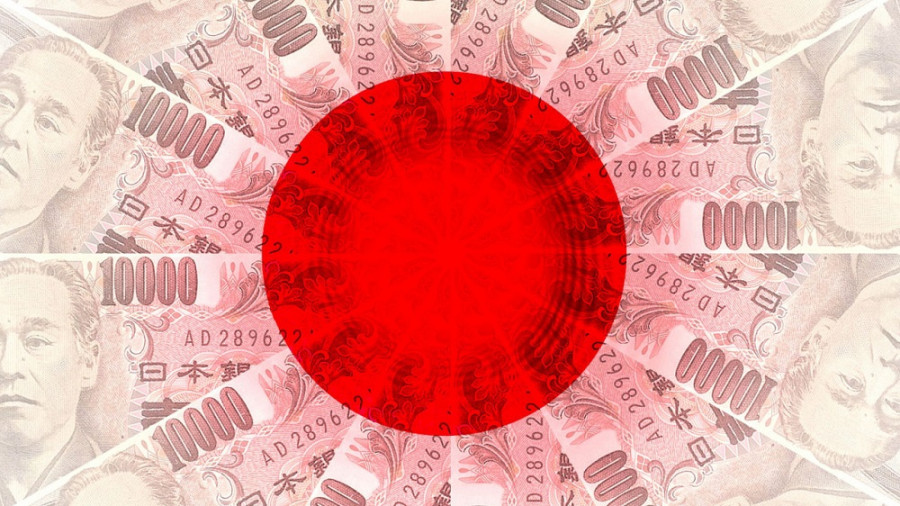See also


 10.04.2025 12:59 AM
10.04.2025 12:59 AMThe GBP/JPY pair is in free fall. Just a week ago, the cross was approaching the 196.00 area, while on Wednesday, sellers pushed it to a new 7-month low at 184.38. In other words, the pair has fallen over 1,000 points in a week, driven by the pound's weakness and the yen's role as a safe-haven currency amid escalating tariff tensions. Demand for the yen remains elevated due to its protective status, and the current downtrend is likely to persist, considering the aggressive rhetoric and actions from Trump, China, and the European Union.
Note that this "southern marathon" in GBP/JPY began on April 2nd — the day President Trump unveiled his new tariff plan, which spooked investors and triggered turbulence across global financial markets. What makes the current situation unique is that the beneficiary this time is not the U.S. dollar — which usually acts as a safe haven in such scenarios — but the yen, which has become the go-to currency for hedging against rising U.S. recession risks.
Therefore, GBP/JPY's directional bias is closely tied to the trajectory of the trade war. Should Trump begin rolling back tariffs and signing bilateral deals, the yen would weaken, allowing GBP/JPY buyers to regain control. However, if the trade war continues to escalate—as it currently does—the yen will likely maintain its dominance, and GBP/JPY will keep updating new multi-month lows.
For example, on Wednesday, traders reacted to the latest escalation in the tariff battle between the U.S. and China. Initially, the U.S. announced 54% tariffs on all Chinese imports (already a record high), to which Beijing responded with 34% tariffs on U.S. goods. Trump immediately retaliated with another 50%, bringing the total U.S. tariff level on Chinese imports to 104%.
But the "tariff battle" didn't end there: on Wednesday, China announced it would impose an additional 50% tariff on U.S. imports starting on Thursday (April 10), bringing its total to 84%.
This confirms that the trade war between the world's two largest economies is intensifying, and the prospect of a deal is becoming increasingly remote.
At the same time, China's Ministry of Commerce signaled it is ready to raise the stakes if the U.S. continues to escalate. According to a ministry spokesperson, "China has the resolve and the means to counteract firmly and fight to the end."
The trade war with the European Union is also heating up, with EU exports now subject to 20% U.S. tariffs. President Trump rejected the EU's proposal to fully eliminate tariffs on industrial goods, calling it "insufficient." In response, Brussels plans to impose retaliatory tariffs on a wide range of U.S. products — reportedly worth €21 billion.
Against this backdrop, stock markets are once again in decline. Tokyo's Nikkei closed down 3.9%, Hong Kong's Hang Seng lost 4.3%, London's FTSE 100 dropped over 2.3%, and the European Stoxx 600 fell 2.6%, among others. At the same time, safe-haven assets — gold, the Swiss franc, and the yen — are in high demand.
Thus, despite the prior 1,000-point drop, the current fundamental backdrop favors continued declines in GBP/JPY. The bearish trend remains intact, and unless Donald Trump unexpectedly announces a "tariff amnesty" (which is unlikely), the yen will likely remain in demand as a safe-haven asset.
From a technical standpoint, GBP/JPY is moving within a descending channel, confirming the strong bearish trend. This is supported by the Ichimoku indicator on the daily and weekly charts, where a bearish "Parade of Lines" signal has formed, confirming the dominance of short positions. On higher timeframes, the price is either at the lower boundary or between the middle and lower lines of the Bollinger Bands indicator, which is currently expanded and below all Ichimoku lines (except on the monthly timeframe).
The first downside target is the Kijun-sen line on the monthly chart, which aligns with the 182.50 level. The primary target lies lower, at 179.00, the lower line of the Bollinger Bands on the MN timeframe. It would be reasonable to lock in profits and adopt a wait-and-see approach in this price area.
You have already liked this post today
*The market analysis posted here is meant to increase your awareness, but not to give instructions to make a trade.
Markets are already fatigued by the chaos unfolding in Donald Trump's mind and among his followers. Everything remains extremely unclear, so market participants are now fully focused on today's important
A considerable number of macroeconomic events are scheduled for Wednesday, but we doubt they will have any meaningful impact on currency pair movements. The market continues to ignore most macroeconomic
The GBP/USD currency pair saw a slight downward correction after Monday's rise, which came out of nowhere. However, it's difficult to call this minor move a "dollar recovery." The U.S
Your IP address shows that you are currently located in the USA. If you are a resident of the United States, you are prohibited from using the services of InstaFintech Group including online trading, online transfers, deposit/withdrawal of funds, etc.
If you think you are seeing this message by mistake and your location is not the US, kindly proceed to the website. Otherwise, you must leave the website in order to comply with government restrictions.
Why does your IP address show your location as the USA?
Please confirm whether you are a US resident or not by clicking the relevant button below. If you choose the wrong option, being a US resident, you will not be able to open an account with InstaTrade anyway.
We are sorry for any inconvenience caused by this message.

